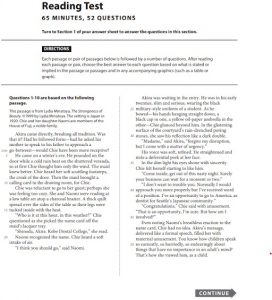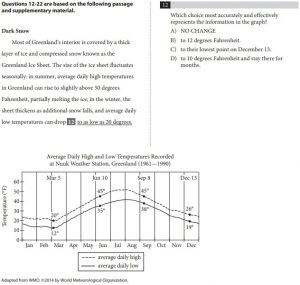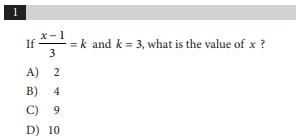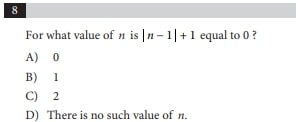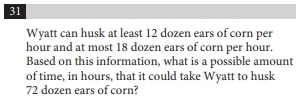
SAT Exam Guide: All About the In-Person SAT
Welcome to the beginning of MEK’s Exam Guide series. In this series, we are providing an in-depth look at all of the major exams we offer to provide a better understanding of what each test consists of, how they are scored, and general expectations. To kick our series off, we are looking at the SAT exam. This is a long-standing pillar of the college application process that has undergone a few recent changes. Specifically, this article will look at the traditional paper SAT rather than the digital version of the exam. If you would like more information regarding the digital SAT, please check out this article that will share some insight into the new format!
General SAT Information
As previously mentioned, the SAT is a common consideration for any student during their process of applying to colleges. This test measures a student’s core competency throughout their primary school education. It also determines their readiness for higher education. Although some universities have removed the requirement for students to submit SAT scores during their application, the inclusion of this test can help students stand out from the crowd by further proving their college-readiness.
The Structure of the SAT
The SAT is measures a student’s knowledge and ability to perform successfully while in school. This is done by testing the applicant on the three sections of the exam: Reading, Writing and Language, and Math. Each section has a different amount of time for a varying number of questions.
- Reading – 65 minutes, 52 multiple choice questions
- Writing and Language – 35 minutes, 44 multiple choice questions
- Math
- No Calculator – 25 minutes, 15 multiple choice questions, 5 grid-in questions
- Calculator – 55 minutes, 30 multiple choice questions, 8 grid-in questions
Each of these sections is slightly different from each other, the specifics of which we will cover a little later in the article. These topic separations also come into play in the calculation of a student’s final score.
How the SAT is Scored
As with any type of test, the goal for students taking the SAT is to score as high as possible. For the SAT, scores range from a minimum of 400 to a maximum of 1600. It is also important to understand how this score is calculated to provide some more insight. The final test score is a sum of two section scores: Evidence-Based Reading and Writing, and Math. The Reading and Writing and Language test determines the first section score. The Math test determines the second section score. Each section score has a range from 200 to 800 based on the raw score from each test, which is essentially just how many questions a student got right. Then, the raw score is converted into a final section score. This conversion process considers the differences in difficulty across SAT test versions allowing for more equivalent comparison.
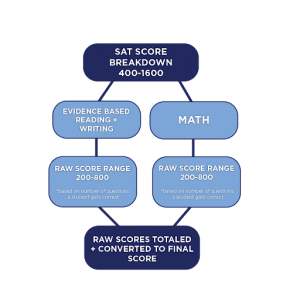
While there are a few more intricacies regarding how sections are scored involving things such as sub-scores and cross-test scores, generally they are not as influential at helping students with test-taking strategies and understanding their performances. For more about SAT scoring, please check out this page from the official CollegeBoard website to learn more!
The Differences Between Each SAT Section
Now, we’ll take a closer look at each of the tests within the SAT, understanding the differences in format between each and even providing some examples of what questions from each part could look like.
The Reading Test
This section is composed of five literary passages, including four standalone passages and one pair of passages. Each of these passage sets are between 500 and 750 words long. In terms of where these passages will come from, the section is set to have 1 fictional passage, 1 or 2 passages from or about a US founding document, 1 passage about a social science such as economics or psychology, and 2 passages from scientific works.
Paired with these passages are questions that test students on three broad categories.
1. How the Author Uses Evidence
These types of questions look to determine a student’s understanding of the use of evidence to support a claim. They also ask testers to identify what part of a passage supports the author’s point, finding evidence that best supports a previous answer, or finding a relationship between a graphic and the passage it comes with.
2. Understanding the Use of Words in Context
One of the most common question types, these questions will ask the test-taker to provide the meaning of a word given the context of the sentence and paragraph. Students must use context clues to determine not only the meaning but also the impact on style and tone.
3. Analyzing History and Science
Some questions will also require students to examine provided hypotheses, interpret given data, and consider potential implications of an author’s claim or evidence.
The following is an example of what a Reading passage might look like, along with an example of a question.
The Writing and Language Test
The second section of the SAT focuses on a student’s ability to use proper language when it comes to writing by identifying mistakes and weaknesses in provided passages. The section contains 4 passages, each being between 400 and 450 words long. While the difficulty and topic of each passage varies, the implemented scoring curve allows students to be judged fairly across different test versions. However, regardless of the focus of each passage, students can consistently expect at least 1 narrative passage, meaning it describes events in a story-like way. The other passages will be either argumentative or informative and explanatory.
Of the 44 questions, each passage comes with 11 questions falling under two types: those focusing on improving the expression of ideas and those centered around recognizing and correcting errors in structure, grammar, usage, and punctuation. These two categories are otherwise known as Expression of Ideas and Standard English Conventions.
Expression of Ideas questions are then further divided into three kinds
- Development – focuses on main ideas, topic sentences, supporting details, etc.
- Organization – focuses on logical sequence and placement of information
- Effective Language Use – asks for improving precision and considering style and tone
The following is an example of what a Writing passage might look like, along with an example of a question.
The Math Test
The final section is Math, focusing on the areas that eventually play significant roles in determining college and career readiness. As stated previously, the Math test is separated into two subsections, those being the calculator and no-calculator sections. Students can use a calculator for the calculator section but cannot during the no-calculator section. Within both subsections there are multiple choice and grid-in questions, which are essentially open-ended questions.
With regards to the types of topics covered by questions in this section, the test encompasses four different sections of math, each with their own unique names.
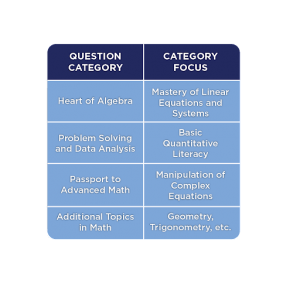
The following is an example of what some math questions might look like.
No Calculator
Calculator
How Can You Begin to Prepare for the SAT
Now that you know more about the SAT, the next step is to decide whether or not this is the right test for you. For many students the SAT is the primary test they choose to take for their college application process. However, many others also opt to take the ACT test instead, providing a new set of different challenges and question types for students to take on. If you’d like to learn more about the ACT, please check out the next part of the series for our ACT Exam Guide!
However, if you’ve now decided that the SAT is the right test for you, MEK has a host of programs that will help you reach your goals.
Check out our programs for:
- 9th & 10th Graders looking to get a head start on SAT Prep: SAT Core
- First-time Test Takers: SAT Foundation, SAT 1400, SAT 1500
- Experienced Test Takers: SAT Advanced
- One-on-one Private SAT Test Prep
To get started with the registration process or to see where you stand on this tough college admissions exam, sign up for one of our SAT Practice Tests. You can take the test virtually from the comfort of your home computer or in-person at our state of the art Closter campus.
After the test, you’ll receive our signature detailed score report. This report outlines your results, including your specific strengths and weaknesses and a plan for improvement. Plus, you have access to a free needs based assessment with one of our counselors. During this meeting, you discuss, one-on-one, our recommended courses and a specialized plan that will get you to your goal score.
Call us at +1 (855) 346-1410 or contact us today to get started!


